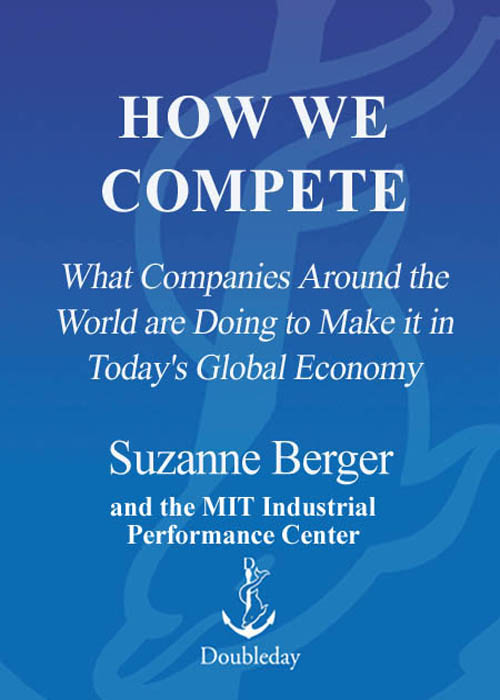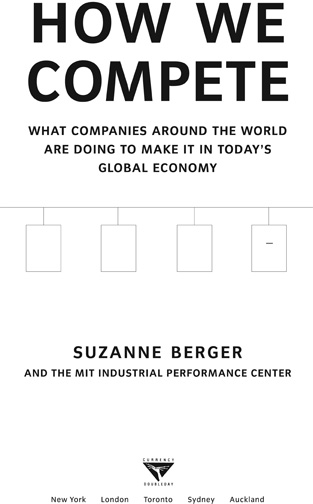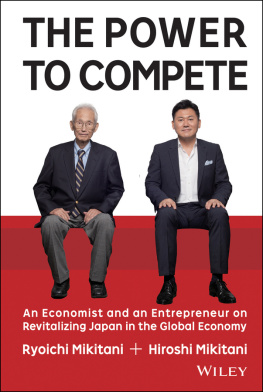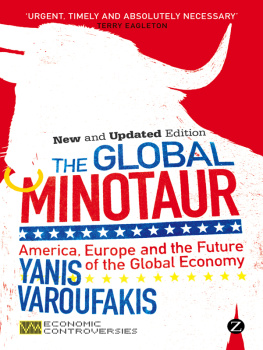

Contents
In memory of our colleague Michael L. Dertouzos
19362001
His leadership in Made in America continues to bear fruit.
His vision of technology joined to social well-being
continues to inspire.
Acknowledgments
How We Compete draws on research that thirteen of us at the Industrial Performance Center at MIT carried out in 19992004. Thirteen names cannot fit on a book cover, but we are together the authors of these ideas and conclusions. At the end, though, one of us had the task of converting the research and the insights we had accumulated over the life of the project into this book, and I am responsible for it, as well as for any mistakes. Along the way, many others were generous colleagues on our five-year journey into the global economy. In addition to those MIT students listed as team members, we also benefited from the help of Thomas Becker, Shiri Breznitz, Zachary Cahn, Jean Charroin, John-Paul Ferguson, Brian Hanson, Llewelyn Hughes, and Georgeta Vidican. Brad Buschurs ingenuity and intelligence as a research assistant demonstrated that almost any fact worth knowing can be extracted from the Web. Through good times and bad, Anita Kafka shepherded the researchers, their declining resources, and their rising mountain of data. This was the dream team.
We thank MIT colleagues Frank Levy, Richard Locke, and Michael Piore for help throughout the study. No act of kindness matters more to a writer than a friendly readers detailed, idea-by-idea critique. For this, I am grateful to Arnaldo Camuffo (University of Padova), Peter Gourevitch (University of California, San Diego), and Richard Samuels (MIT), who offered penetrating suggestions and encouragement. The team is indebted to colleagues outside the United States for much we have learned in collaborative projects running in parallel with the Globalization Study: to Volker Wittke, Uli Voskamp, and Michael Faust at the Soziologisches Forschungsinstitut (SOFI) in Goettingen, Germany, with whom we are collaborating in joint research supported by the Volkswagen Foundation; to Jun Kurihara, Kennedy School, Harvard University, for research supported by the Fujitsu Research Institute; to Christel Lane, Simon Learmount, and Jocelyn Probert at the University of Cambridge, in joint research supported by the Cambridge-MIT Institute (CMI); and to Zhao Chunjun, dean of the School of Economics and Management, Tsinghua University, Beijing, Peoples Republic of China, who introduced us to the dynamic Chinese companies in Zhejiang Province. In addition to the institutions that backed the international collaborations, the Alfred P. Sloan Foundation, the Taiwan Ministry of Economic Affairs, and the Chinese National Federation of Industries (Taiwan) were generous funders of the Industrial Performance Center Globalization Study.
Finally, the book owes everything to the hundreds of busy executives who agreed to interviews that took hours of their time. Somelike John Glidden at L. W. Packard and Chikara Hayashi at Ulvacmet with us repeatedly over the years of the research. They showed us their factories, introduced us to their managers and suppliers, and patiently walked us through the details of the thousands of day-to-day decisions that add up to a strategy for globalization. When I asked for permission to name names and use direct quotes, most of them saw why an unvarnished account that describes failures as well as successes is usefuland they agreed.
This report on globalization in the trenches is itself a product of the very same processes it studies. The manuscript was acquired by Roger Scholl, editorial director of Currency Doubleday, an imprint within an American division of Random House, located in New York City, and owned by Bertelsmann, whose headquarters are in Guetersloh, Germany. Sarah Rainone of Currency Doubleday edited the manuscript, which was then contracted out to Chris Fortunato of Fortunato Book Packaging (Pearl River, New York), who was responsible for coordinating the design, copyediting, typesetting, proofreading, and indexing. Tina Henderson of Metairie, Louisiana, was the designer and compositor of the book. The book was copyedited by Peter Grennen, who lives in Bow, New Hampshire, and the index was created by Charlee Trantino, who lives in Harveys Lake, Pennsylvania. The text was printed and bound by Berryville Graphics in Berryville, Virginia; the books jacket was designed by Michael Windsor of Doubleday, and printed by Coral Graphics of Hicksville, New York. Prior to its delivery to booksellers throughout the United States, the book will be stored in the Random House Warehouse in Westminster, Maryland. But I cannot tell who sold you the book. Let me knowso we can reconstruct the last link in the value chain that stretched from the glimmer in the mind of MIT researchers into your hands: http://www.howwecompete.com. You will also find more facts and figures about the Globalization Study on this Web site, along with working papers from the project and information about the ongoing research.
A Readers Guide to a Few Unfamiliar Terms
CM: contract manufacturer; a company (like an ODM or OEM or EMS, see below definitions) that manufactures on order for a lead or brand firm but has no brands of its own.
EMS: electronics manufacturing services contract manufacturers.
DRAM: semiconductor memory. Dynamic random access memory.
Fab: short for fabrication factory; a silicon-wafer-manufacturing plant that makes semiconductor chips out of raw silicon wafers.
Global supplier: large specialist contract manufacturerfor example, Flextronics.
IC: integrated circuit. An electronic circuit containing various electronic devices such as transistors, resistors, and capacitors fabricated on a single semiconductor substrate. They are often called chips. Printed circuit boards (PCBs) are generally made of layers of epoxy (not silicon) with metal wires embedded to create circuits. So they are circuit boards but not ICs. ICs and other chips are mounted on PCBs.
IDM: integrated device manufacturer; companies that make integrated circuitsfor example, Intel.
Manufacturer: in most industries, the company that does physical production of goods. In apparel, though, manufacturer has come to mean the company that designs and markets clothesfrequently also the owner of a brand, and sometimes the owner of the goods being processed (fabric, trim).
Maquiladora: companies in Mexico that process or assemble inputs shipped from the United States (usually) and exported (usually) to the United States.
MNC: multinational corporation; one that owns and operates facilities in more than one country.
Modularity: a term used here to describe the technological and organizational possibilities for breaking apart a production system that might once have been contained within a vertically integrated company and having independent companies carry out these functions.
ODM: original design manufacturer; a company that does designs and manufacturing for brand-name firms. An ODM does not have its own brand. The ODMs are doing more and more design (in contrast to the OEMs).
OEM: original equipment manufacturer; a company that makes products on order or for sale to brand-name firms. An OEM does not have its own brand or develop new designs. OEMs are also called contract manufacturers.
PC: personal computer.
Pure play: a business carrying out one function with no brand name. Its used mainly to describe pure-play semiconductor foundries, which make silicon chips for multiple customers but do not design the chips or make products using them.
Next page














